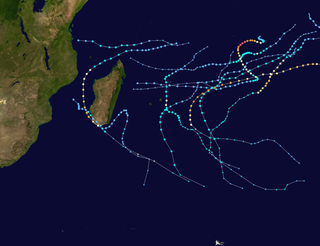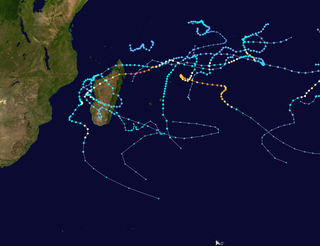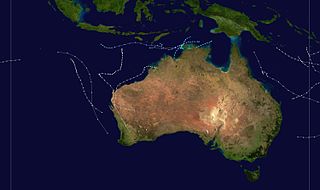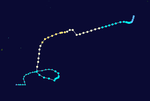
Very Intense Tropical Cyclone Gafilo was both the most intense tropical cyclone ever recorded in the South-West Indian Ocean and the most intense tropical cyclone worldwide in 2004. Being unusually large and intense, Gafilo was the deadliest and most destructive cyclone of the 2003–04 South-West Indian Ocean cyclone season. According to the EM-DAT International Disaster Database, Gafilo killed at least 363 people. Gafilo also caused about $250 million damages in Madagascar, which makes it one of the most devastating storms to hit the country on reliable record.

The 2006–07 South-West Indian Ocean cyclone season featured the second-most intense tropical cyclones for a season in the tropical cyclone basin, only behind the 2018–19 season. The basin contains the waters of the Indian Ocean south of the equator and west of 90°E. Météo-France's meteorological office in Réunion (MFR), the official Regional Specialized Meteorological Center for the South-West Indian Ocean, tracked 15 tropical disturbances, of which eleven attained gale-force winds. The season began in October 2006 with a short-lived tropical disturbance, followed by Anita in November, which was the first named storm of the season. Cyclone Bondo was the first of six intense tropical cyclones, which took a rare track through the southern Seychelles before making landfall on northwest Madagascar, killing 11 people. Severe Tropical Storm Clovis lasted from December 2006 to January 2007; it struck eastern Madagascar, killing four people.

The 2005–06 South-West Indian Ocean cyclone season was the fifth least-active on record. The Météo-France office on the island of Réunion tracked 13 tropical disturbances, of which six intensified into a moderate tropical storm. Three of these systems proceeded to attain tropical cyclone status – reaching 10 minute maximum sustained winds of at least 120 km/h (75 mph). The American-based Joint Typhoon Warning Center also tracked eight storms in the basin. Activity was below normal due to a powerful Walker circulation, which increased convection over the neighboring Australian basin, but suppressed activity in the western Indian Ocean. As a result, most of the storms developed near or entered from the Australian basin, crossing 90°E to enter the South-West Indian Ocean.

The 2004–05 South-West Indian Ocean cyclone season was a near average season, despite beginning unusually early on August 30 with the formation of an early-season tropical depression. Météo-France's meteorological office in Réunion (MFR) ultimately monitored 18 tropical disturbances during the season, of which 15 became tropical depressions. Two storms – Arola and Bento – formed in November, and the latter became the most intense November cyclone on record. Bento attained its peak intensity at a low latitude, and weakened before threatening land. Tropical Cyclone Chambo was the only named storm in December. In January, Severe Tropical Storm Daren and Cyclone Ernest existed simultaneously. The latter storm struck southern Madagascar, and five days later, Moderate Tropical Storm Felapi affected the same area; the two storms killed 78 people and left over 32,000 people homeless. At the end of January, Severe Tropical Storm Gerard existed as an unnamed tropical storm for 18 hours due to discrepancies between warning centers.

The 2003–04 South-West Indian Ocean cyclone season featured the most intense tropical cyclone in the South-West Indian Ocean, Cyclone Gafilo, as well as nine other named storms. Tropical activity began on September 28 when Moderate Tropical Storm Abaimba formed at a low latitude. Activity continued until late May, following Severe Tropical Storm Juba, which marked the third year in a row that a storm formed in May. The final disturbance, one of sixteen, dissipated on May 24. Activity was near average, and the season was one of the longest on record.

The 1998–99 South-West Indian Ocean cyclone season was a quiet season that had the fourth-lowest number of days with tropical storm or tropical cyclone activity. Most of the storms formed either in the Mozambique Channel or in the far eastern portion of the basin, with five storms crossing from the adjacent Australian basin east of 90° E. As a result, few storms impacted Madagascar, and none made landfall on the African continent. Throughout most of the season, there was below-normal sea surface temperatures in the Indian Ocean east of Madagascar. In February, typically the peak in activity, Réunion island recorded its highest average monthly pressure since 1953. Due to generally unfavorable conditions, there were only six tropical storms tracked by the Météo-France office (MFR) on Réunion. There were only two tropical cyclones – a storm with winds of at least 120 km/h (75 mph).

The 1974–75 Australian region cyclone season was an above average tropical cyclone season.

The 1980–81 South-West Indian Ocean cyclone season was an average cyclone season.

The 1981–82 South-West Indian Ocean cyclone season was destructive and deadly in Madagascar, where four cyclones killed 100 people and caused $250 million (USD) in damage. The season was fairly active, lasting from October to May. There were nine named storms that attained gale-force winds, or at least 65 km/h (40 mph). Five of the storms attained tropical cyclone status, which have 10-minute sustained winds of at least 120 km/h (75 mph).

The 1989–90 South-West Indian Ocean cyclone season was an average cyclone season, with nine named storms and five tropical cyclones – a storm attaining maximum sustained winds of at least 120 km/h (75 mph). The season officially ran from November 1, 1989, to April 30, 1990. Storms were officially tracked by the Météo-France office (MFR) on Réunion while the Joint Typhoon Warning Center (JTWC) in an unofficial basis. The first storm, Cyclone Alibera, was the second longest-lasting tropical cyclone on record in the basin, with a duration of 22 days. Alibera meandered and changed directions several times before striking southeastern Madagascar on January 1, 1989, where it was considered the worst storm since 1925. The cyclone killed 46 people and left widespread damage. Only the final storm of the year – Severe Tropical Storm Ikonjo – also had significant impact on land, when it left $1.5 million in damage (1990 USD) in the Seychelles.

The 1988–89 South-West Indian Ocean cyclone season was an active season that featured several storms moving near or over the Mascarene Islands or Madagascar. The eleven tropical storms was two greater than average, of which five became tropical cyclones – a storm with maximum sustained winds over 10 minutes of 120 km/h (75 mph) or greater. Storms were monitored by the Météo-France office (MFR) on Réunion island in an official capacity, as well as the American Joint Typhoon Warning Center (JTWC) on an unofficial base. The season began early with Moderate Tropical Storm Adelinina forming in early November, and continued through the middle of April. Adelinina was one of two storms to form in November, the other being Tropical Cyclone Barisaona which crossed from the adjacent Australian basin.

The 1987–88 South-West Indian Ocean cyclone season was a moderately active cyclone season, with nine named storms. Four of the storms attained tropical cyclone status, which is the equivalent of a minimal hurricane with 10 minute sustained winds of at least 120 km/h (75 mph). The seasonal activity was evenly dispersed, officially beginning on December 9 when the Météo-France office (MFR) on Réunion started tracking Tropical Storm Ariny. The storm crossed 90° E from the adjacent Australian basin, one of two storms in the season to do so along with Cyclone Ezenina. There were also two storms tracked unofficially by the Joint Typhoon Warning Center (JTWC) in November.

The 1986–87 South-West Indian Ocean cyclone season was below average due to an ongoing El Niño and a weak monsoon that suppressed convection and storms. There were only five named storms tracked by the Météo-France office (MFR) on Réunion. The United States-based Joint Typhoon Warning Center (JTWC) followed four other storms in the basin, which is the waters of the Indian Ocean south of the equator and west of 90° E to the coast of Africa. The JTWC tracked a storm on August 1 in the northeastern portion of the basin, unusual for the time of year. The first named storm was Severe Tropical Storm Alinina, which originated from the Intertropical Convergence Zone east of Madagascar in the middle of January. However, there was an unnamed tropical depression that produced heavy rainfall in Réunion and Madagascar, causing two deaths in the latter country.

The 1967–68 South-West Indian Ocean cyclone season was an above average cyclone season.

The 1972–73 South-West Indian Ocean cyclone season was an above-average cyclone season. The season officially ran from November 1, 1972, to April 30, 1973.

The 1974–75 South-West Indian Ocean cyclone season was a below-average cyclone season. The season officially ran from November 1, 1974, to April 30, 1975.

The 1975–76 South-West Indian Ocean cyclone season was a below-average cyclone season. The season officially ran from November 1, 1975, to April 30, 1976.

The 1978–79 South-West Indian Ocean cyclone season was an average cyclone season. The season officially ran from November 1, 1978, to April 30, 1979.

The 1979–80 South-West Indian Ocean cyclone season was an above-average cyclone season. The season officially ran from November 1, 1979, to April 30, 1980.

Since 1656, at least 300 tropical cyclones have affected the Mascarene Islands in the southern Indian Ocean. The archipelago consists of several islands, including Mauritius, Réunion, and Rodrigues. Mauritius claims responsibility for several Outer Islands, including St. Brandon and Agaléga, and has disputed territorial claims of Tromelin Island and the Chagos Archipelago. The deadliest tropical cyclone to affect the region was one that struck Mauritius in 1892, which killed 1,200 people, left 50,000 people homeless, and destroyed one-third of the capital Port Louis.
































